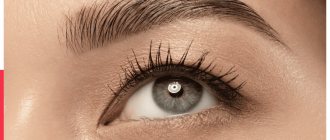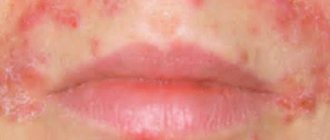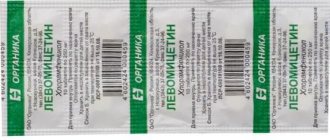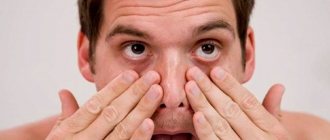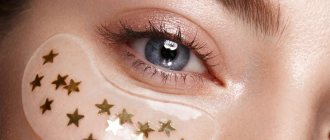Puffiness under the eyes is caused by the accumulation of a large amount of fluid in this area , which is not distributed evenly, but is localized under the skin. There can be reasons for - from harmless to serious and pathological.
Therefore, if swelling of the lower eyelid does not go away within a few days and cannot be eliminated using the simplest folk methods, it is recommended to consult a specialist.
Features of swelling under the eyes
Swelling under the eyes is always clearly visible to the naked eye, even to a non-specialist, especially since such a disorder is seen by the person himself in the mirror.
Note! Sometimes the swelling may not be as noticeable, and it can be difficult to determine whether it is actually swelling or slight skin deformities that occur after sleep.
Pathological swelling that requires action is always characterized by the following symptoms :
- change in skin color under the eyes;
- slight or strong feeling of skin tension in the area of edema;
- the tissues in the area of edema become slightly denser.
In some cases, such formations may be accompanied by painful sensations.
But this does not happen due to the development of subcutaneous pathological processes, but due to strong tension of the skin and the creation of pressure under it due to the accumulation of fluid.
What causes swelling of the eyelids and what should be done to relieve it?
Swelling may occur in one eye or both. In such cases, they speak of unilateral or bilateral edema, respectively. Most often the upper eyelids swell. This can happen for various reasons - pathological and non-pathological. The first group of factors includes eye diseases and diseases of other organs. Swelling of the eyelids is almost always observed with the development of inflammatory ophthalmopathologies. Among them:
- keratitis;
- blepharitis;
- conjunctivitis;
- iridocyclitis;
- barley.
The eyelids also swell with some systemic ailments - diseases of the kidneys, liver, blood vessels, diabetes mellitus, allergies, abdominal dropsy. Swelling of the upper eyelid is a very common symptom that cannot be called specific. It is difficult to determine from this sign alone whether it is a consequence of any pathology. However, often the eyelids swell for reasons that are not related to disease.
The difference between swelling and bags under the eyes
Some people do not attach importance to the difference between edema and bags, and in everyday understanding, both of these names apply to the same phenomenon.
In fact, edema usually means a pathological accumulation of fluid in the infraorbital or supraorbital area .
It is worth noting! Bags are an exclusively dermatological problem, since they are formed folds of skin.
Almost always, the reason for the formation of bags lies not in pathologies, but in the loss of elasticity of the skin with age, as a result of which fatty tissue is not retained in it and the skin structures lose their shape.
How to remove swelling from the eyelids?
Swelling occurs due to the accumulation of a large volume of fluid in the intercellular space. The skin around the eyes is the thinnest.
In this article
- How to remove swelling from the eyelids?
- The most common causes of eyelid swelling
- How to relieve swelling of the eyelids after drinking alcohol?
- Eyelids are swollen after tattooing - what to do?
- How to remove swelling from the upper eyelid using folk remedies?
- How does massage help remove swelling from the upper eyelids?
- How else can you remove swelling from your eyelids?
Because of this, swelling appears on the eyelids or under the eye sockets. Other parts of the body also swell, but on the face it becomes immediately noticeable. Swelling of the eyelid or eye is not only a cosmetic problem. This symptom may signal the development of a disease, not necessarily related to the organs of vision. Let's look at all the possible causes of eyelid swelling and find out how to remove them.
Causes
There are dozens of pathological and non-pathological reasons for the development of puffiness under the eyes. As a rule, in these cases the symptom occurs simultaneously under the left and right eye.
Harmless reasons
Relatively harmless non-pathological causes include:
- sleep disorders (irregular sleep, insomnia, sleeping at different times);
- problems with excess weight (in this case, a violation of the water-salt balance develops, and some of the fluid accumulates under the eyes);
- exposure to regular long-term stress ;
- excessive consumption of alcoholic beverages;
- unhealthy diet (abuse of fatty and salty foods in particular);
- constant exposure of the skin to sunlight and wind , frequent changes in ambient temperature;
- excessive physical activity or, on the contrary, a sedentary lifestyle . In both cases, the balance of fluid in the body is also disturbed and its uneven distribution occurs.
With such problems, eliminating the root cause yourself is usually not difficult, and swelling can be eliminated at home using cosmetics or traditional medicine.
Diseases
Remember! It is worse if the cause of such a violation is pathological conditions and lesions, for which the intervention of specialists cannot be avoided.
Such reasons include:
- Problems with venous or lymphatic drainage . In such situations, the outflow pathways of venous blood or lymph are blocked, as a result of which such fluids stagnate in different parts of the body. But such places of congestion under the eyes are especially noticeable, since the skin here is quite thin. Such disorders can occur both in various ophthalmological inflammatory diseases and as a result of unsuccessful cosmetic procedures.
- Pathologies of internal organs . Disturbances in circulatory processes are characteristic of diseases of the thyroid gland, kidneys and cardiovascular system.
- Ophthalmological diseases accompanied by inflammatory processes. Most often, barley, conjunctivitis, chalazion and furunculosis. In these cases, swelling does not occur due to fluid accumulation, but due to structural changes in the affected tissues.
- Diseases of the paranasal sinuses (any type of sinusitis). Swelling in this case is explained by the close location of the pathological areas to the organs of vision. And the swelling itself does not develop in the under-eye area, but spreads from the maxillary sinuses, where it initially appears.
Important! Often the cause of the development of swelling is allergic reactions, with additional symptoms being irritation, redness of the conjunctiva, itching, sneezing, and lacrimation.
Heredity should not be ruled out: some people have a genetic predisposition to puffiness under the eyes.
And this is often observed in newborns, in whom such a disorder can persist in the first few months of life and then disappear.
Treatment of skin allergies around the eyes
The first priority action when signs of allergy occur is to stop contact with the allergen. If symptoms appear for no apparent reason, you should change your position, take a shower, and wash your face. This increases your likelihood of reducing your exposure to the allergen, even if you don't understand what caused the symptoms.
Additionally, antihistamines must be taken, preferably second generation4. These drugs include drugs based on cetirizine, for example, Cetrin. The work of drugs in this group is to block histamine receptors, thereby relieving the clinical manifestations of allergies. The drugs begin to act in 15-20 minutes, so they quickly improve a person’s condition4.
Additional general recommendations:
- Do not rub your eyes, this aggravates the clinical manifestations.
- Use corticosteroid ointments with caution (it is advisable to consult with specialists before using this).
- Choose your antihistamine carefully.
- During treatment, avoid cosmetics, creams and any chemical products for your facial skin.
- If you are allergic to animals or pollen, do wet cleaning more often, wash clothes after returning from the street or contact with an animal.
The rate of disappearance of symptoms is influenced by: the amount and duration of exposure to the allergen, the body’s reactivity, and the use of an antihistamine.
Features of symptoms in women
In women, swelling under the eyes occurs more often than in men. Firstly, women's skin is thinner and more delicate, and secondly, there are a number of specific “female” reasons :
- Obviously, women cry more often , but swelling does not always occur. However, tears can absorb moisture that comes out with them. At the same time, tears contain substances that irritate the skin. The combination of these factors causes swelling.
- used by women often cause ophthalmological diseases and the development of allergic reactions , even if such products are of good quality. Sometimes the development of edema is promoted not by the components themselves that make up cosmetics, but by neglect of hygiene rules. This is the use of other people's accessories and cosmetics, removing makeup with products not intended for this purpose, excessive mechanical impact on the skin in the process of removing shadows and mascara. But the main problem remains allergic reactions. Therefore, before purchasing cosmetics, you need to familiarize yourself with the composition. And if you are sure that you are allergic to specific components present in a certain product, you should refuse to purchase it.
- Puffiness may occur under the eyes during the menstrual cycle. Since during this period hormonal changes occur, as a result of which the outflow of fluid may be disrupted.
Swelling can only during pregnancy , especially in the first trimester.
During this period, the concentration of the hormone estrogen increases in the female body, which in large quantities can retain fluid in the body.
This explains swelling in pregnant women not only in the eye area, but also swelling of the limbs.
Could swelling be a symptom of an allergy?
An allergic reaction is one of the common causes of swelling. This happens because mast cells release biologically active proteins to neutralize allergens. But when combined with irritants, they cause a reaction that is similar to inflammation. Hence the swelling and redness of the eyelids. Among the ophthalmological causes of eyelid swelling, the most common are:
- glaucoma;
- conjunctivitis;
- periorbital cellulitis;
- eyelid tumors;
- injuries;
- insect bites;
- thermal, chemical burns.
Often the appearance of swelling is the body’s reaction to smoke, dust and other irritants from the external environment.
Diagnostics
It is worth noting! If you are sure that such processes occur due to possible diseases of the eyes or internal organs, you need to contact a therapist who will prescribe a number of diagnostic procedures, including:
- Blood pressure measurement.
- Donating blood to perform a general analysis , which can show the presence of inflammatory processes in the body.
- Analysis of urine . It also allows you to diagnose inflammation, provided that an increased number of leukocytes is detected in the material for analysis.
- Radiography . It is not always prescribed, but only if there is suspicion of compression of blood vessels by neoplasms of various origins in the eye area, which leads to swelling.
- Ultrasound of the kidneys.
- Additional blood tests to determine the level of thyroid hormones. Additionally, an ultrasound of the thyroid gland may be performed. In these cases, it is possible to identify changes in this organ that lead to hormonal imbalance.
- Echocardiography and electrocardiography . The methods allow us to identify disorders of the cardiovascular system.
Attention! If necessary, examinations by other specialists can be prescribed, and based on the diagnostic results, a diagnosis will be made with subsequent treatment.
Treatment options
Therapeutic methods for the problem are selected based on the general clinical picture and the final diagnosis.
Know! To do this, you need to visit a number of specialists and pass a list of tests. Self-medication in this case can lead to serious complications.
General approach
If you are sure that the problem was not caused by any serious internal disorders , you can use the following algorithm, which will allow you to get rid of swelling in a short time:
- take diuretics . It is best to choose natural ingredients, such as lingonberries or bearberry;
- take antihistamines . An example is suprastin. This measure will help alleviate the condition if the disease was caused by an allergy;
- Apply a cold compress to your eyes.
If after a series of procedures your condition does not return to normal within 24 hours or, on the contrary, worsens, you should visit a specialist who will determine the exact cause.
Medications
Note! Drug treatment is prescribed based on the general diagnosis. These may be the following types of medications:
- antihistamines;
- diuretics;
- drugs to normalize kidney function;
- hormonal agents;
- anti-inflammatory;
- antibiotics.
If you need to get rid of swelling in a short time, you can resort to special ointments .
Despite the fact that the remedies listed below are not intended for such a purpose, they nevertheless have an almost immediate effect.
How to remove swelling of the eyelids?
Swelling from the eyelid can be eliminated at home, in a clinic or in a salon. It all depends on what is causing the symptom, whether you have the time and money or not. If the nature of the swelling is pathological, then you first need to see a doctor. Typically, swelling of the eyelids as a symptom of the development of an eye disease is accompanied by the following signs:
- hyperemia or pallor;
- transillumination of blood vessels;
- lacrimation;
- itching and burning;
- thickening of the cartilage of the eyelid;
- pain;
- discharge of mucus or pus.
If you have several of these symptoms, you should see an ophthalmologist. It is dangerous to relieve swelling from the eyelid using folk remedies or medicines that are in your home medicine cabinet. The disease may become more complicated. If you are sure that swelling of the eyelid is not a consequence of the development of the disease, you can use the recipes of the so-called traditional medicine. Let's find out what you can urgently do to get rid of puffiness.
Why can the eyelid of only one eye swell?
Most ophthalmological pathologies (especially those caused by pathogenic microorganisms) are bilateral - both organs of vision are affected at once.
But swelling of the upper eyelid can sometimes appear only in the left or right eye. often occurs due to colds of infectious origin .
It is worth noting! This is also a characteristic sign of allergic dermatitis, which occurs when an allergen comes into direct contact with the skin.
Typically, swelling of one eye that occurs in the upper eyelid spreads further along the face, but it may not spread to the other half of the face.
The most common cause of unilateral swelling is injury or insect bites - that is, local damage that does not spread further along the surface.
Such swelling is always short-lived and, with first aid and symptomatic therapy, disappears within a few days.
How to remove swelling from the upper eyelid using folk remedies?
You can quickly get rid of swelling of the eyelids with the help of lotions, compresses and face masks. They do not cure diseases, but help soothe the skin and muscles, which promotes the outflow of excess fluid. On the Internet you can find many recipes that are used to relieve swelling of the eyelids. Let's list some of them:
- Cold. Everyone has ice cubes in their refrigerator. They need to be wrapped in gauze or bandage and applied to closed eyelids for 1-2 minutes. The eyes should not be too cold. It is better to apply ice to the eyelids intermittently.
- Carrot. Make a mask from the grated vegetable. You can apply it not only to the upper eyelids, but also to the skin under the eyes, the bridge of the nose, and cheekbones.
- Flax seeds. They need to be filled with hot water and left overnight. The resulting broth is filtered. Lotions are made from it and applied to the eyelids for 10-15 minutes. This remedy is believed to help with swelling and inflammation. However, if there is an inflammatory process, it should be treated by a doctor.
- Tea with mint. Tea may have a decongestant effect. Tea compresses are applied to the eyes for 15-20 minutes. Instead of tea leaves, you can also use plants such as chamomile, calendula, thyme, fireweed, and sage.
- Chilled milk. Tampons are moistened in it and left on the upper eyelids for 20-25 minutes. Also, some supporters of traditional medicine suggest using other dairy products - cottage cheese or sour cream.
- Raw potatoes. It can be cut into circles or grated on a fine grater to make compresses.
- Egg white. It has an astringent effect. Apply to eyelids for 15-20 minutes, then wash off with warm water. Daily use of eggs in this way helps smooth out wrinkles on the eyelids.
These products help to slightly eliminate swelling. There are more effective methods. Let's find out how to remove swelling from the upper eyelids using massage.
The most common causes of eyelid swelling
Swelling of the eyelids appears due to hormonal imbalances, as a result of visual fatigue, injury, after an insect bite, due to prolonged exposure to ultraviolet radiation on the eyes and skin.
In some cases, swelling occurs briefly after taking certain medications. However, the most common causes of edema are:
- alcohol consumption;
- poor nutrition;
- tattoo;
- overwork.
Let's look at these reasons in more detail and list ways that help quickly remove swelling.


